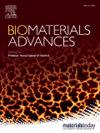Nanosheet-shaped WS2/ICG nanocomposite for photodynamic/photothermal synergistic bacterial clearance and cutaneous regeneration on infectious wounds
IF 5.5
2区 医学
Q2 MATERIALS SCIENCE, BIOMATERIALS
Materials Science & Engineering C-Materials for Biological Applications
Pub Date : 2025-01-16
DOI:10.1016/j.bioadv.2025.214192
引用次数: 0
Abstract
Bacterial infections present a significant threat to human health, a challenge that is intensified by the slow pace of novel antibiotic development and the swift emergence of bacterial resistance. The development of novel antibacterial agents is crucial. Indocyanine green (ICG), a widely used imaging dye, efficiently generates reactive oxygen species (ROS) and heat for treating bacterial infections but suffers from aggregation and instability, limiting its efficacy. In this study, tungsten disulfide (WS₂) nanosheet with a high surface area was used to load ICG, creating a multifunctional nanocomposite, WS2/ICG, aimed at treating bacteria-infected wounds. The two-dimensional surface structure of WS₂ provides dispersible binding sites for ICG, and the synthesized nanocomposite exhibits excellent stability. Under near-infrared (NIR) laser excitation, the generated heat further synergistically enhances the yield of singlet oxygen. Additionally, the WS₂/ICG nanoplatform synergistically combines photothermal effect with photodynamic effect, achieving a “1 + 1 > 2” enhancement. Upon NIR laser excitation, the nanocomposite disrupts bacterial cell membranes through localized heating and ROS accumulation, leading to energy metabolism system disruption and subsequent bacterial lysis and death. The findings demonstrate WS₂/ICG's outstanding antibacterial properties and biocompatibility, effectively treating skin infections and promoting tissue regeneration, providing a simple and promising solution for bacteria-infected wounds.
求助全文
约1分钟内获得全文
求助全文
来源期刊
CiteScore
17.80
自引率
0.00%
发文量
501
审稿时长
27 days
期刊介绍:
Biomaterials Advances, previously known as Materials Science and Engineering: C-Materials for Biological Applications (P-ISSN: 0928-4931, E-ISSN: 1873-0191). Includes topics at the interface of the biomedical sciences and materials engineering. These topics include:
• Bioinspired and biomimetic materials for medical applications
• Materials of biological origin for medical applications
• Materials for "active" medical applications
• Self-assembling and self-healing materials for medical applications
• "Smart" (i.e., stimulus-response) materials for medical applications
• Ceramic, metallic, polymeric, and composite materials for medical applications
• Materials for in vivo sensing
• Materials for in vivo imaging
• Materials for delivery of pharmacologic agents and vaccines
• Novel approaches for characterizing and modeling materials for medical applications
Manuscripts on biological topics without a materials science component, or manuscripts on materials science without biological applications, will not be considered for publication in Materials Science and Engineering C. New submissions are first assessed for language, scope and originality (plagiarism check) and can be desk rejected before review if they need English language improvements, are out of scope or present excessive duplication with published sources.
Biomaterials Advances sits within Elsevier''s biomaterials science portfolio alongside Biomaterials, Materials Today Bio and Biomaterials and Biosystems. As part of the broader Materials Today family, Biomaterials Advances offers authors rigorous peer review, rapid decisions, and high visibility. We look forward to receiving your submissions!
文献相关原料
公司名称
产品信息
阿拉丁
Bulk WS?
阿拉丁
Bulk WS2
阿拉丁
Bulk WS2
阿拉丁
Bulk WS2

 求助内容:
求助内容: 应助结果提醒方式:
应助结果提醒方式:


